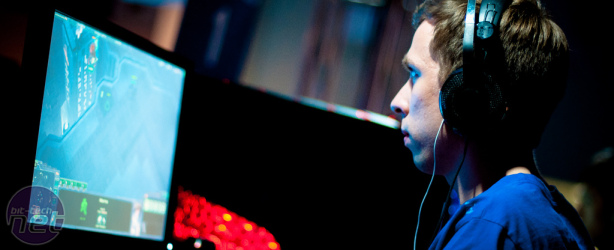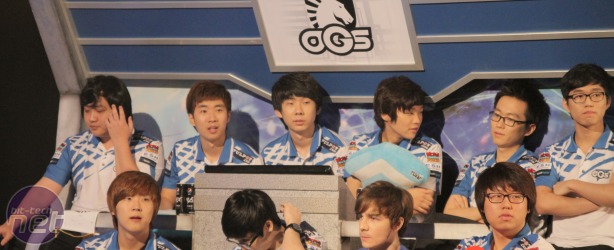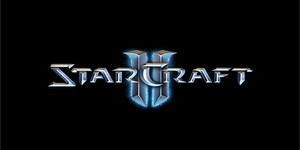
The World Of Professional Starcraft
The final enemy explodes with a pyrotechnic flourish and a capitulatory 'gg' hits the chat. A forlorn white flag beaten into the keyboard by the broken fingers of your vanquished opponent. Arms raised aloft, you gaze regally about the monitor-lit room, a thousand imagined voices bellowing in honour of your prowess. A triumphal roar punctuates your conquest in the guise of a powerful victory scream. Your partner comes in to tell you that the tea's ready.
For even the most lowly RTS player, the simple joy of victory can elevate you to Sun-Tzu like levels of self assurance. It is, however, an exclusively private experience. No matter how vehemently you explain a game-winning strategy to your friends, they are unlikely to start asking for your autograph. For some gamers though, baying crowds and celebrity status are the exactly what follow from that hard-earned 'gg'.

Superstars
This is the everyday of South Korean Starcraft superstars. Ever since Blizzard unsheathed its real-time strategy opus in 1998, the East Asian nation has been madly in love. Today, the country purrs to the sound of 2,000 PC Bangs, each crammed full of kids maniacally hammering at their keyboards. These players come back day after day, not only because they enjoy the game, but because they know that for the truly gifted, fame and glory await in the Global Starcraft League.
In Korea, becoming the GSL champion means more than just proving yourself to a cadre of geeks. Starcraft is truly mainstream, with its most famous players featuring on television all year around.
To truly understand how endemic it is, consider that when pro gamer Jung-Min ‘Zenio’ Chio was asked how he felt about playing on the same team as legendary player Lee Yoon ‘NaDa’ Yeol, he claimed to be honoured because these were players he ‘used to watch on TV’. To our ears, those sound like the comments of a young footballer who’s just finished 90 minutes with Ryan Giggs.
Starcraft II has been the dominant force in Korean gaming since 2010, but for many years its predecessor, Starcraft: Brood War, was the eternal zeitgeist. Thanks to a string of tournament victories, the likes of Boxer, NaDa, and MvP became household names. Now they advertise products alongside pop stars and fill arenas whenever they play.
The GSL
Fans with dreams of ascending to the same level need to be in the GSL. Introduced in 2010, this Starcraft II league runs multiple times a year and offers its best players thousands of dollars in prizes. Consistent winners can earn enough to kick themselves comfortably beyond the 99%.

2012’s first GSL season is currently underway, with the remaining 32 players split into Champions League style groups. Leafing through the standings, it’s notable that every player is attached to a team. In 2002, like-minded players began to band together with fellow competitors to form official squads. These players found that training together provided an invaluable edge over the competition and team membership quickly became the norm.
Thanks to Korea’s ceaseless appetite for Starcraft, corporate sponsors were only too happy to bankroll gangs of potential superstars. Nowadays you’re highly unlikely to see anyone step into the bright lights of the GSL without a patchwork of sponsorship logos.
If you doubt the effectiveness of joining a team, just take a look at the GSL‘s current Round of 32. The same names appear over and over again. Teams MVP, oGs, and StarTale all have at least three players still in the running. SlayerS has six.
Next: Dedication, and the UK scene.
The final enemy explodes with a pyrotechnic flourish and a capitulatory 'gg' hits the chat. A forlorn white flag beaten into the keyboard by the broken fingers of your vanquished opponent. Arms raised aloft, you gaze regally about the monitor-lit room, a thousand imagined voices bellowing in honour of your prowess. A triumphal roar punctuates your conquest in the guise of a powerful victory scream. Your partner comes in to tell you that the tea's ready.
For even the most lowly RTS player, the simple joy of victory can elevate you to Sun-Tzu like levels of self assurance. It is, however, an exclusively private experience. No matter how vehemently you explain a game-winning strategy to your friends, they are unlikely to start asking for your autograph. For some gamers though, baying crowds and celebrity status are the exactly what follow from that hard-earned 'gg'.

Become a star, without leaving your computer
Superstars
This is the everyday of South Korean Starcraft superstars. Ever since Blizzard unsheathed its real-time strategy opus in 1998, the East Asian nation has been madly in love. Today, the country purrs to the sound of 2,000 PC Bangs, each crammed full of kids maniacally hammering at their keyboards. These players come back day after day, not only because they enjoy the game, but because they know that for the truly gifted, fame and glory await in the Global Starcraft League.
In Korea, becoming the GSL champion means more than just proving yourself to a cadre of geeks. Starcraft is truly mainstream, with its most famous players featuring on television all year around.
To truly understand how endemic it is, consider that when pro gamer Jung-Min ‘Zenio’ Chio was asked how he felt about playing on the same team as legendary player Lee Yoon ‘NaDa’ Yeol, he claimed to be honoured because these were players he ‘used to watch on TV’. To our ears, those sound like the comments of a young footballer who’s just finished 90 minutes with Ryan Giggs.
Starcraft II has been the dominant force in Korean gaming since 2010, but for many years its predecessor, Starcraft: Brood War, was the eternal zeitgeist. Thanks to a string of tournament victories, the likes of Boxer, NaDa, and MvP became household names. Now they advertise products alongside pop stars and fill arenas whenever they play.
The GSL
Fans with dreams of ascending to the same level need to be in the GSL. Introduced in 2010, this Starcraft II league runs multiple times a year and offers its best players thousands of dollars in prizes. Consistent winners can earn enough to kick themselves comfortably beyond the 99%.

Team oGs
2012’s first GSL season is currently underway, with the remaining 32 players split into Champions League style groups. Leafing through the standings, it’s notable that every player is attached to a team. In 2002, like-minded players began to band together with fellow competitors to form official squads. These players found that training together provided an invaluable edge over the competition and team membership quickly became the norm.
Thanks to Korea’s ceaseless appetite for Starcraft, corporate sponsors were only too happy to bankroll gangs of potential superstars. Nowadays you’re highly unlikely to see anyone step into the bright lights of the GSL without a patchwork of sponsorship logos.
If you doubt the effectiveness of joining a team, just take a look at the GSL‘s current Round of 32. The same names appear over and over again. Teams MVP, oGs, and StarTale all have at least three players still in the running. SlayerS has six.
Next: Dedication, and the UK scene.

MSI MPG Velox 100R Chassis Review
October 14 2021 | 15:04









Want to comment? Please log in.